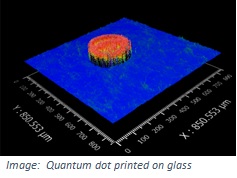June 2020:
High Accμracy Project
Press Release November 2020
Hi-Accμracy – Micro level developments driving great innovations in display technologies
Hi-Accμracy is an ambitious EC Horizon 2020 funded project that aims to develop new ways to produce high-resolution displays, improving how they are used in existing technologies and creating exciting new opportunities for new applications. It commenced in April 2020 and is coordinated by the Austrian non-profit research institute Joanneum Research Forschungsgesellschaft mbH.
In a joint approach, 11 project partners from 6 European countries are developing new printable materials and innovative additive fabrication processes to create next generation display technologies. Materials such as quantum dots (QD), novel organic semiconductors and conductive inks that can be produced at low cost with minimal environmental impact are being developed. Hi-Accμracy will employ a variety of deposition, and new additive fabrication processes, such as electro-static jetting (ESJET), reverse-offset printing (ROP), nano-imprint lithography (NIL), Vapour Deposition (ESAVD) and assisted ion deposition (AAID) to deliver the speed and accuracy required to successfully produce the structures commercially. Hi-Accμracy’s printed structures will be manufactured in a range of resolutions on flexible substrates that could be applied to virtually any surface. These technologies will utilise printed electronics down to µm size, for Organic Large Area Electronics (OLAE), Thin Film Transistor (TFT) and Display Applications.  The end goal for these advances is the development of cost effective, adaptable and more sustainable printed QD based displays with greater resolution and brightness than is currently possible. The three year Hi-Accμracy project is focused on producing a small scale ‘proof of concept’ display screen. But it is anticipated that longer term applications of the technology will be on larger, high-resolution displays for use in venues including transport hubs, civic centres, sports stadia, exhibition halls and road side information and advertising signage. At the other end of the scale it is expected that the Hi-Accμracy’s lightweight, ultra high definition displays will become the basis of personal devices including smart watches, phones, virtual reality headsets and augmented reality screens, as well as being used as Point of Sale displays and digital vehicle dashboards. Centro Ricerche FIAT (CRF) is a Hi-Accμracy partner and has proposed exciting in-car applications of this kind such as the futuristic Chrysler Portal concept.
The end goal for these advances is the development of cost effective, adaptable and more sustainable printed QD based displays with greater resolution and brightness than is currently possible. The three year Hi-Accμracy project is focused on producing a small scale ‘proof of concept’ display screen. But it is anticipated that longer term applications of the technology will be on larger, high-resolution displays for use in venues including transport hubs, civic centres, sports stadia, exhibition halls and road side information and advertising signage. At the other end of the scale it is expected that the Hi-Accμracy’s lightweight, ultra high definition displays will become the basis of personal devices including smart watches, phones, virtual reality headsets and augmented reality screens, as well as being used as Point of Sale displays and digital vehicle dashboards. Centro Ricerche FIAT (CRF) is a Hi-Accμracy partner and has proposed exciting in-car applications of this kind such as the futuristic Chrysler Portal concept.
The global market for printed, flexible and organic electronics is projected to grow annually by about 8.5% to a value exceeding $77billion (US) by 2029, and Hi-Accμracy aims to place Europe at the heart of this growth.
Dr. Pufinji Obene of Precision Varionic International, a UK based Hi-Accμracy consortium partner, said ‘with input from our industry partners, SONY, Huawei and Polar, this innovative project aims to produce a highly marketable display technology, which will be the catalyst for improvements to existing devices, including mobile phones, making the use of screens more immersive and engaging for us all.’
The Hi-Accµracy consortium is: Joanneum Research forschungsgesellschaft mbH, Bionanonet Forschungsgesellschaft mbH, Centro Ricerche Fiat SCpA, Dycotec Materials Ltd, Fraunhofer Institute for Applied Polymer Research IAP, Humboldt-Universität zu Berlin, Interuniversitair Micro-Electronica Centrum, NeuDrive Ltd, Precision Varionic International Ltd, Teknologian tutkimuskeskus VTT Oy, University College London.
To learn more about these innovations, as well as details about the partner organisations, visit www.hi-accuracy.eu This project has received funding from the European Union’s Horizon 2020 research and innovation programme under grant agreement No. 862410. ENDS